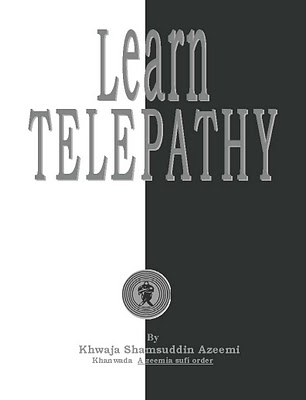Telepathy, from the Greek tele, “distant”, and patheia, “feeling”, is the claimed innate ability of humans and other creatures to communicate information from one mind to another, without the use of extra tools such as speech or body language. Considered a form of extra-sensory perception or anomalous cognition, telepathy is often connected to various paranormal phenomena such as precognition, clairvoyance and empathy. Though many scientific experiments into telepathy have been conducted, including recent ones by respected universities (some claiming significant positive results), telepathy remains controversial and is not widely accepted by scientists.
Telepathy is direct transference of thought from one person (sender or agent) to another (receiver or percipient) without using the usual sensory channels of communication, hence a form of extrasensory perception (ESP). While the existence of telepathy has not yet been proved, some parapsychological research studies have produced favorable results using such techniques as card guessing with a special deck of five sets of five cards. The agent may simply think of a random order of the five card symbols while the percipient tries to think of the order on which the agent is concentrating.
Telepathy in History
Very few anecdotal accounts of telepathy have been noted in many ancient cultures since historical records have been kept.
In the Bible, some prophets appear to have the ability to see into the future (precognition, time travel, grid travel). This seems to be a common claim from ancient and primitive people. But the sending and receiving of messages from individual to individual by mind alone is never mentioned at all. As with all psi phenomena, there is wide disagreement and controversy within the sciences, even within parapsychology, as to the existence of telepathy.
Western scientific investigation of telepathy is generally recognized as having begun with the initial program or research of the Society for Psychical Research. The apex of their early investigations was the report published in 1886 as the two-volume work Phantasms of the Living.
It was with this work that the term “telepathy” was introduced, replacing the earlier term “thought transference”. Although much of the initial investigations consisted largely of gathering anecdotal accounts with follow-up investigations, they also conducted experiments with some of those who claimed telepathic abilities. However, their experimental protocols were not very strict by today’s standards.
In 1917, psychologist John E. Coover from Stanford University conducted a series of telepathy tests involving transmitting/guessing playing cards. His participants were able to guess the identity of cards with overall odds against chance of 160 to 1; however, Coover did not consider the results to be significant enough to report this as a positive result.
Perhaps the most well-known telepathy experiments were those of J. B. Rhine and his associates at Duke University, beginning in the 1927 using the distinctive ESP Cards of Karl Zener. These involved more rigorous and systematic experimental protocols than those from the 19th century, used what were assumed to be ‘average’ participants rather than those who claimed exceptional ability, and used new developments in the field of statistics to evaluate results. Results of these and other experiments were published by Rhine in his popular book Extra Sensory Perception, which popularized the term “ESP”.
Another influential book about telepathy in its day was Mental Radio, published in 1930 by the Pulitzer prize-winning author Upton Sinclair (with foreword by Albert Einstein). In it Sinclair describes the apparent ability of his wife at times to reproduce sketches made by himself and others, even when separated by several miles, in apparently informal experiments that are reminiscent of some of those to be used by remote viewing researchers in later times. They note in their book that the results could also be explained by more general clairvoyance, and they did some experiments whose results suggested that in fact no sender was necessary, and some drawings could be reproduced precognitively.
By the 1960s, many parapsychologists had become dissatisfied with the forced-choice experiments of J. B. Rhine, partly because of boredom on the part of test participants after many repetitions of monotonous card-guessing and refusing the suggestion by magicians of adding cards that were totally blank, partly because of the observed “decline effect” where the accuracy of card guessing would decrease over time for a given participant, which some parapsychologists attributed to this boredom.
Some parapsychologists turned to free response experimental formats where the target was not limited to a small finite predetermined set of responses (e.g., Zener cards), but rather could be any sort of picture, drawing, photograph, movie clip, piece of music etc.
As a result of surveys of spontaneous psi experiences which reported that more than half of these occurred in the dreaming state, researchers Montaque Ullman and Stanley Krippner at the Maimonides Medical Center in Brooklyn, New York, undertook a series of experiments to test for telepathy in the dream state.
A “receiver” participant in a soundproof, electronically shielded room would be monitored while sleeping for EEG patterns and rapid eye movements (REMs) indicating dream state.
A “sender” in another room would then attempt to send an image, randomly selected from a pool of images, to the receiver by focusing on the image during the detected dream states. Near the end of each REM period, the receiver would be awakened and asked to describe their dream during that period. The data gathered suggested that sometimes the sent image was incorporated in some way into the content of the receiver’s dreams.
While the dream telepathy experiments results were interesting, to run such experiments required many resources (time, effort, personnel). Other researchers looked for more streamlined alternatives, such as the so-called ganzfeld experiments.
To date there has not yet been any satisfactory experimental protocol designed to distinguish telepathy from other forms of ESP such as clairvoyance.There have been rare claims of shared of visual hallucinations in folie a deux shared psychotic disorder. These are beyond the scope of science at this time. The phenomena cannot be produced or reproduced on demand.
Telepathy and Science
Telepathy proponents point generally to controversially scientific concepts such as psychology and quantum mechanics, as areas of research that are considered to be deeply based in the scientific method, but have equally problematic and unexplainable links to the exclusively physical description of reality.
Quantum Mechanics
In seeking a “scientific explanation,” some telepathy proponents have claimed there to be connections between scientific quantum theory as a basis for telepathy. Such modern concepts of telepathy have attempted to draw both legitimacy and scientific curiosity, by making both general and specific analogies between the “unaccepted unknowns” of religion and parapsychology, and the “accepted unknowns” in the quantum sciences, where the classical and understood concepts of physics (time and space) don’t generally apply. The clear example is in quantum mechanics and its inherently theoretical cousin, string theory. Both have radically changed modern concepts regarding the nature of time, space, energy, and matter, and the relationships between each.
In general the concept is that the mind (human or otherwise) is simply evolved physical scaffold for an entity of electrical and quantum impulses. This system, in turn is claimed to have been developed abilities to influencing and receiving “quantum fluctuations” from other minds. In essence, proponents claim that telepathy is not “extrasensory”, rather that the brain is the telepathic organ, its connections to other brains are not physical, but psychic, and the very definition of the psychic medium is the localized inertial frame of reference which is affected by the mind.
This new and “scientifically-grounded” concept of telepathy provides the context for further speculations. However, physicists and skeptics state that quantum mechanics does not show classical effects until objects are at sub-nanometer scales, and since the physical components of the mind are all much larger, these quantum effects are considered negligible. Proponents counter that the scientific statements carry two flawed assumptions, namely that the experience of telepathy need be a classical effect, and that the mind is sensitive to only classical effects.
Some physicists, such as Nick Herbert, have pondered whether or not quantum mechanics’ “non-locality” (or “spooky action at a distance”) principle would permit instantaneous communication such as telepathy. Experiments have been conducted (by scientists such as Gao Shen at the Institute of Quantum Physics in Beijing, China) to study whether or not quantum entanglements (connections allowing instantaneous information exchange) demonstrated at the level of electrons can also be verified between human minds. Such experiments usually include monitoring for synchronous EEG patterns between two hypothetically “entangled” minds.
Technologically-assisted telepathy
Some, for example the science-fiction writer Spider Robinson in the book Deathkiller, have envisioned neurological research leading to technologically-assisted telepathy, also called techlepathy. As of 2004, scientists have demonstrated that brain imaging can be successfully used to recognise distinct thought patterns, and tell, for example, whether experimental monkeys thought about juice or water, and whether a human participant thought about a rotating cube or moving his paralyzed arm. Both implanted electrodes recording neurons’ activity and outside electrodes recording electromagnetic activity of the brain can be used.
Telepathic communication between humans and animals
Some people believe that it is possible for humans and animals to communicate through telepathy. In the past, this type of interspecies communication was thought to be a normal part of life, such as in Native American culture. For more information on this subject, see books by Rupert Sheldrake (Dogs who know when their owners are coming home), and professional animal communicators Penelope Smith and Marta Williams.
Delusions of telepathy – Schizophrenia can produce delusions that the sufferer is in telepathic communication with others; such delusions include thought broadcasting and thought extraction.
Other Facts
There is a long tradition of anecdotal evidence for foreseeing the future in dreams and by various devices such as observing the flight of birds or examining the entrails of sacrificial animals. Precognition has been tested with subjects required to predict the future order of cards in a deck about to be shuffled or to foretell results of dice throws, but the statistical support for it has generally been less convincing than that from experiments in telepathy and clairvoyance.
Telepathy is instinctual. Primitive species used it as a survival mechanism. It involves mind to mind contact – communication – of one mind with another by means beyond the normal or ordinary – beyond the frequencies of the five physical senses – sight, hearing, touch, taste, smell.
No all psychics are telepathic or can read minds.
Telepathic abilities are about connecting frequency. It is like turning on a radio and finding the right station. You just have to know how to ‘tune in’ and the frequency of the program. For a few people this skill comes easy – but on the norm – telepathy is never developed though many people try. Different meditation techniques and learning to focus the mind are the key. The more you practice the better you get.
Once you open the door to telepathy – it should work like a light switch. You can turn it off – tune off – or turn it on by focusing your thoughts. Rarely does one find that they are bombarded by the thoughts of others all the time. It would drive you crazy.
Human DNA is not activated in a way that makes us natural telepaths – in most cases. We are in the third dimension – the physicalrealms -to experience emotions. Telepathy would make it more complicated than it already is. Of course no one would be able to lieanymore – so perhaps humanity could live in peace – but that is not why we come into the physical. We experience here as if in a Matrix – the Holodeck – a Virtual Reality game – for the drama, the emotions – the thrills and chills – until one day we pause thegame and say, “I am tired of this. I can think ‘out of the box’ and want those skills returned. Give me back my powers.” It is then we go in seek of the tools which are innately ours.
Dreams bring telepathic messages as we time ravel or grid travel in our dreams where al exists. These are called precognitive dreams. If they are about the ‘world’ rather than our personal lives, they are called ‘collective dreams’.
Deceased souls sometimes bring messages through dreamtime. Communication is by thought form using symbols. In dreams youare moving faster than the speed of light. This is similar to meditation, time travel and remote viewing. You meet up with spirits and share adventures and information. In dreamtime you move faster and higher.
As your consciousness returns to the physical body the lower your get to your body – the more it slows down …slower…and slower… until you enter your consciousness mind and wake up in the sluggish place – we call 3D. it is here that the concept of lineartime exists. You can best understand this by remembering that in your dreams – you move from event to event but time is notmarked. There is no time beyond 3D as frequency of light – and that is all we are – is moving too fast. Remember – the lower and slower the frequency – the less likely to achieve telepathy or other abilities that work in faster light. 3D appears to be as dull as it gets.
Lovers definitely are more in tuned telepathically as being in love at that level is a very high frequency. This is not just about sex – though it is an aspect of it. Sexual activity is often telepathic in that one is responding to the needs of their partner on a higher level of expression.
Telepathy between members of the same family – or close friends is common as they learn to adjust to each other’s frequencies. There always seem to be one member of every family – usually a woman – who has psychic or telepathic abilities. Mother’s sense when children are in trouble. When you are in panic mode – the adrenaline flows and the telepathy kicks in to those would tune in to help you.
I woman could receive messages from her unborn child, often through dreams, but also telepathically.
People often sense the death of a family member. These make the most dramatic stories – heightened tension, nick-of-time rescues. However, keep in mind that telepathic situations may be happening all the time, but we lack the awareness to recognize them. In times of crisis we sent out our message and those who are in tune will pick it up.
Twins are often telepathic with each other creating these abilities when they are infants. they generally are in the same frequency at the same time and learn to communicate with words. very often it is just about a single thought – hunger. Telepathy between twins or family members can remain for a life time.
Something to ponder over yet more than research, experience is the most powerful way to believe in such phenomena.


